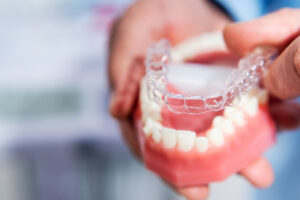Invisalign has become a popular choice for people looking to straighten their teeth without traditional braces. But for many who are considering Invisalign, a key question comes up: “Does Invisalign hurt?” While Invisalign is designed to be a more comfortable and convenient option, it’s normal to wonder about potential discomfort.
Discover what you can expect in terms of soreness or pain, when it’s likely to happen, and why it’s actually a sign that the aligners are doing their job.
Understanding Invisalign and Discomfort: Does Invisalign Hurt?

When you first start with Invisalign, it’s completely normal to experience some level of discomfort. Invisalign works by gradually shifting your teeth over time, and to do this, each aligner applies gentle, steady pressure. This process can cause a mild, often temporary soreness in your teeth and gums. This especially when you’re just starting or switching to a new set of aligners.
What to Expect
Most people describe the feeling as mild pressure rather than pain. This pressure is your aligners applying force to move your teeth into their ideal positions. Initially, you may feel the sensation is unusual, but it typically fades within a few days as your mouth adjusts.
Why Some People Experience Discomfort
Each time you insert a new set of aligners, they’re slightly different from the last. They’re designed to push your teeth a little further toward their end positions, which explains why new aligners often bring a renewed sense of tightness. This feeling is usually strongest in the first 24-48 hours of wearing a new set, then diminishes as your teeth start to adjust to their new positions.
When Does Invisalign Hurt the Most?
Invisalign isn’t usually associated with ongoing pain. However, certain points during the process are known to be more uncomfortable than others. Understanding these moments can help you prepare for minor soreness and adjust as needed.
First Few Days with a New Set of Aligners
The most common time for Invisalign discomfort is during the first few days of using a new aligner set. With each new aligner, your teeth are shifted slightly more, creating a sensation of pressure. This discomfort is often most noticeable when you first put the aligners in or when you’re biting down. However, it’s temporary, typically lasting just a few days with each new set.
Types of Discomfort
There are a few specific kinds of discomfort that Invisalign users commonly report:
- Pressure: You’ll likely feel a consistent pressure on your teeth, especially in the early days of each aligner set. This pressure can be a bit intense initially, but it usually means the aligners are working as intended.
- Soreness: Many users experience slight soreness in their gums and teeth. This can feel similar to the discomfort of traditional braces.
- Irritation: Sometimes, the edges of the aligners can rub against the inside of your mouth, causing minor irritation on your gums or tongue. This tends to be mild and can be managed with orthodontic wax if needed.
While these types of discomfort are common, they’re generally manageable. The good news is that these sensations tend to subside within a few days, leaving you with a comfortable fit for the rest of the two-week wear period before switching to your next set of aligners.
Why Does Invisalign Cause Discomfort?
To understand why Invisalign may cause some discomfort, it helps to look at how it works. Unlike traditional braces, which use metal wires and brackets to shift teeth, Invisalign aligners are custom-made trays designed to apply consistent pressure to specific areas of your teeth. Each set of aligners is slightly different from the last, guiding your teeth to move incrementally closer to their final positions. This gradual process is gentle, but it does involve some minor soreness.
How Aligners Work to Move Teeth
Invisalign aligners are crafted to push your teeth in specific directions, which they accomplish by applying steady pressure. As your teeth begin to move, your body adjusts to these changes, leading to a short adjustment period each time you start wearing a new aligner set. This pressure may feel like tightness or mild aching, but it’s simply a sign that the aligners are working as they should.
Reasons for Soreness
The main reason for soreness is the force exerted by the aligners on your teeth, which is necessary to create movement. Here’s a breakdown of what causes this sensation:
- Pressure from Aligners: Since each new aligner is slightly modified to bring your teeth closer to their ideal position, it needs to apply a gentle force to encourage movement. This pressure is essential for shifting teeth, but it may feel uncomfortable in the first day or two of each new aligner set.
- Adjustment Period: The feeling of soreness typically decreases as your mouth adjusts to the new aligners. Most people find that this discomfort only lasts a few days, after which the aligners feel more comfortable.
Does Invisalign Hurt Less Than Braces?
For many people, one of the biggest appeals of Invisalign is the promise of a more comfortable experience compared to traditional braces. While both Invisalign and braces work to shift your teeth over time, they differ in how they do it—and that can impact the level of discomfort you feel.
Comparison with Traditional Braces
Traditional braces use metal brackets and wires that are adjusted periodically to realign your teeth. These adjustments often cause soreness for a few days each month. They can also lead to irritation due to the metal hardware rubbing against the inside of your mouth. In contrast, Invisalign aligners are made from a smooth plastic material, reducing the likelihood of cuts and sores.
Here’s how Invisalign compares to traditional braces in terms of comfort:
- Wires vs. Smooth Aligners: Invisalign aligners are made from a clear, BPA-free plastic. This means they don’t have the sharp edges or metal components that can cause mouth sores with braces. Aligners’ smooth design can feel less invasive and generally results in fewer instances of irritation.
- Reduced Mouth Sores: Traditional braces can cause sores where the metal wires and brackets rub against the gums and cheeks. Invisalign aligners cover the teeth without any sharp edges, making it easier on the soft tissues in your mouth.
- Gradual Adjustments: With braces, adjustments are typically made once a month. This can lead to a sudden increase in soreness as the wires are tightened. Invisalign, however, involves switching to a new aligner every one to two weeks, meaning the adjustments are more gradual. This approach often results in less intense discomfort overall, as your teeth are moved in smaller, more consistent steps.
Tips to Reduce Discomfort During Invisalign Treatment
While some initial soreness is common with Invisalign, there are several simple and effective ways to manage discomfort and make the process as smooth as possible. Here are some tried-and-true strategies to help minimize soreness and keep your Invisalign experience comfortable.
Simple Solutions for Immediate Relief
Does Invisalign hurt? If you’re feeling discomfort after switching to a new set of aligners, these quick remedies can provide immediate relief:
- Over-the-Counter Pain Relievers: Taking ibuprofen or acetaminophen can help reduce soreness in the first few days of each new aligner set. Follow the dosage guidelines, and you should feel more comfortable as your teeth adjust.
- Cold Compress: Applying a cold compress to the outside of your mouth can help numb any pain and reduce inflammation. Hold the compress against the sore area for 10-15 minutes to ease discomfort.
Preventive Measures
In addition to addressing discomfort when it arises, taking some proactive steps can help you avoid or reduce soreness in the first place:
- Use Orthodontic Wax: If your aligners rub against your gums or tongue, you can apply orthodontic wax to the edges. This adds a protective layer and can prevent irritation from constant friction.
- Chewies: Invisalign chewies are small, soft chewable cylinders that help seat your aligners more securely. Chewing on them for a few minutes each day ensures that your aligners are properly fitted, which can reduce the sensation of tightness and help prevent irritation.
Long-Term Tips for Comfort
Consistency and good habits play a big role in reducing Invisalign discomfort over time. Here’s how you can create a smoother Invisalign journey:
- Stay Consistent with Wear Time: Wearing your aligners for the recommended 20-22 hours per day helps your teeth adjust faster and with less pain. Consistency minimizes discomfort by allowing your teeth to adapt steadily.
- Follow the Orthodontist’s Instructions: Your orthodontist will provide guidelines specific to your treatment. These may include when to switch aligners or how to manage discomfort. Sticking to these instructions can help prevent unnecessary pain and ensure steady progress.
Does Invisalign Hurt at Night?
For many people, Invisalign discomfort tends to feel more noticeable at night. Since you’re less distracted and more focused on relaxing, any soreness or tightness may stand out more. Let’s explore why this happens and some strategies for a better night’s sleep with Invisalign.
Potential Nighttime Soreness
When you wear a new set of aligners, the pressure on your teeth is at its peak in the first few days. This can sometimes make sleeping uncomfortable. Such discomfort usually fades as your mouth adapts. However, you might still notice mild soreness at night when your mouth is at rest.
Here’s why discomfort can feel stronger at night:
- Relaxation Heightens Awareness: During the day, you’re usually occupied with work, socializing, or other activities that keep you focused elsewhere. At night, though, you might become more aware of the tightness or mild pain caused by your aligners.
- Body’s Natural Response: Just like with other dental devices, your body might initially react to having something new in your mouth, especially during rest, when it’s not used to constant pressure.
Tips for a Comfortable Night
Does Invisalign hurt for you at night? Fortunately, there are a few steps you can take to make sleeping with Invisalign more comfortable:
- Warm Compress Before Bed: Applying a warm compress to your jaw can help relax any tension and relieve minor soreness before you head to bed. This can reduce tightness and make it easier to fall asleep.
- Pain Relief Options: If the discomfort is distracting, consider taking a mild pain reliever about 30 minutes before bed. This can reduce soreness throughout the night and help you rest without interruption.
- Stay Consistent: Sticking to the recommended wear schedule of 20-22 hours per day ensures that your teeth adjust consistently, which can reduce nighttime discomfort over time.
Experience Orthodontic Care That Puts You First
If you’re considering Invisalign or any orthodontic treatment, Lasley Orthodontics in Renton, WA, is here to make your experience comfortable, effective, and uniquely suited to your needs. Dr. Andrew Lasley and his team are committed to providing award-winning care for every patient, ensuring you feel supported at each step of your treatment journey.
Our practice emphasizes a personalized approach—focused on quality, not quantity—so you can feel confident knowing that your smile is in capable, caring hands. With a wide range of treatment options, including Invisalign, self-ligating braces, and orthodontic appliances, we’re prepared to meet the needs of patients of all ages, from children to adults.
Book your complimentary exam today to discover how Lasley Orthodontics can help you achieve a beautiful, healthy smile tailored just for you.

